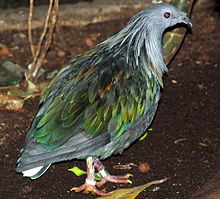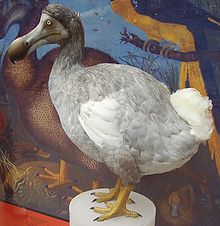- Raphinae
-
Raphines
Temporal range: RecentDodo reconstruction reflecting new research at Oxford University Museum of Natural History Conservation status Scientific classification Kingdom: Animalia Phylum: Chordata Class: Aves Order: Columbiformes Family: Columbidae Subfamily: †Raphinae
Wetmore, 1930Genera †Pezophaps
†RaphusSynonyms Dididae Swainson, 1835
Raphidae Poche, 1904 (unavaliable)
Pezophabidae Hachisaka, 1953The Raphinae are a subfamily of extinct flightless birds colloquially called didines or didine birds.[1] They inhabited the Mascarene Islands of Mauritius and Rodrigues, but became extinct through hunting by humans and predation by introduced non-native mammals following human colonisation in the 17th century.
Contents
Overview
 The Nicobar Pigeon (Caloenas nicobarica) is the closest living relative of the dodo and the Réunion Solitaire.
The Nicobar Pigeon (Caloenas nicobarica) is the closest living relative of the dodo and the Réunion Solitaire.
This clade is part of the order Columbiformes and contains the monotypic genera Pezophaps and Raphus. The former contains the species Pezophaps solitaria (the Rodrigues Solitaire), the latter the Dodo, Raphus cucullatus. These birds reached an impressive size as a result of isolation on predatorless islands in accordance with Foster's rule.
The "Réunion Solitaire", long considered a third extinct didine bird, has turned out to be an ibis; it is now known as Threskiornis solitarius.
The didines are often separated as a distinct family Raphidae, and their affinities were for long uncertain; they were initially placed within the ratites due to their peculiar, flightlessness-related apomorphies, and a relationship to the Rallidae has also been suggested. Osteological and molecular data, however, agrees that placement in the Columbidae is more appropriate.[2]
Comparison of mitochondrial cytochrome b and 12S rRNA sequences suggests the Nicobar Pigeon (Caloenas nicobarica) is the closest living relative of the Dodo and the Rodrigues Solitaire. This does not actually imply a very close relationship, however, and at any rate, the molecular phylogeny of the Indo-Australian pigeons has yielded wildly differing results depending on the gene sequence analyzed.[3]
What appears certain, regardless of the closest living relative of the didines, is that they belong to a basal Indo-Australian radiation of pigeons. Apart from the didines, this includes such animals as the Goura crowned pigeons, the Pheasant Pigeon, Ducula and Ptilinopus, and the Nicobar Pigeon. Accordingly, until better material evidence of the didines' ancestry is available, they are here considered a subfamily of the Columbidae.
No good data is available for dating the group's evolution. Based on the data analyzed by Shapiro et al., they gave an estimate of 32–56 mya for the didine-Caloenas divergence. This may or may not be roughly correct; the more precise date of c.43 mya most likely is not since the molecular clock was calibrated with a presumed penguin—Procellariiformes divergence that has since been invalidated by Waimanu. It is far more likely than not, however, that this group's origin lay in the Paleogene than in the Neogene, as indicated by the paleogeography of the W Indian Ocean area, notably the Mascarene Plateau. This would support the view that the Columbidae are among the older landbird lineages among the Neoaves.
Footnotes
References
- Janoo, Anwar (2005): Discovery of isolated dodo bones [Raphus cucullatus (L.), Aves, Columbiformes] from Mauritius cave shelters highlights human predation, with a comment on the status of the family Raphidae Wetmore, 1930. Annales de Paléontologie 91: 167–180. [English with French abstract] doi:10.1016/j.annpal.2004.12.002 (HTML abstract)
- Johnson, Kevin P. & Clayton, Dale H. (2000): Nuclear and Mitochondrial Genes Contain Similar Phylogenetic. Signal for Pigeons and Doves (Aves: Columbiformes). Molecular Phylogenetics and Evolution 14(1): 141–151. PDF fulltext
- Shapiro, Beth; Sibthorpe, Dean; Rambaut, Andrew; Austin, Jeremy; Wragg, Graham M.; Bininda-Emonds, Olaf R. P.; Lee, Patricia L. M. & Cooper, Alan (2002): Flight of the Dodo. Science 295: 1683. doi:10.1126/science.295.5560.1683 (HTML abstract) Supplementary information
Footnotes
External links
 Media related to Raphidae at Wikimedia CommonsCategories:
Media related to Raphidae at Wikimedia CommonsCategories:- Raphinae
- Subfamilies of birds
- Extinct flightless birds
- Higher-level bird taxa restricted to the Malagasy region
- Bird extinctions since 1500
- Fauna of the Mascarenes
Wikimedia Foundation. 2010.


